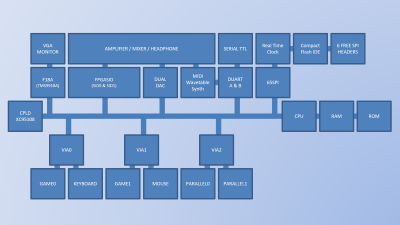I'm going to build my latest project, MARC-3 S “My Adorable Retro Computer-3rd Revision Stackable”.
My two previous designs are single board computers, and the problem I experienced with it is that they are not easy to expand or modify. I’ve thought a lot of how to make an easy to assemble computer. I came up with several designs, but I was never satisfied with them. Eventually my solution is to use Arduino like stackable headers. That way I can make separate boards for processor, glue logic, memory and I/O devices.
For this computer I’ve set myself some goals:
• Self-contained (essentially like an 80’s home computer including mass storage device)
• Expandable (a simple way to test new devices on breadboard, and add them later to the system)
• Modular (separate modules to add or exchange without rebuilding the whole computer)
• 5V DC only (for some devices I’ll use microcontroller or FPGA based replica’s or substitutes, which are 5V DC only and use less power)
• Homemade PCB’s (because of the modular design and to keep costs and waiting times down, I will make my PCB at home.)
• System clock speed is not an issue for this project, anything above 1MHz is acceptable for me.
As for now, I’m going to use the following chips / devices:
The bare minimum for a working computer:
• WDC W65C816S (no introduction

)
• XC9572 or XC95108 PLCC84 (CPLD for glue logic and other functions)
• AS6C4008 (4 x 512KiB of RAM for a total of 2MiB)
• ATmega1284P (microcontroller for ROM emulator and other functions)
• SC28L92 (DUART for TTL serial connection and MIDI)
Expansions I have planned:
• F18A (FPGA based TMS9918A VDP (video display processor))
• WDC W65C22S (3 x for keyboard, mouse, joystick and other functions)
• 65SPI (credits to 8BIT
http://sbc.rictor.org/65spi.html)
• SPI-IDE Interface (credits to 8BIT
http://sbc.rictor.org/IDE.html)
• DS3234 (SPI DeadOn RealTimeClock module)
• FPGASID (FPGA based dual SID MOS6581 / MOS8580)
• DreamBlaster X2 (advanced wavetable synthesizer)
• TLC7528CN (dual 8-bit DA converters for stereo audio)
• Magicforce 68 (mechanical keyboard)
• Optical PS/2 compatible mouse
• TRACO TSR 2-2450 (DC/DC converter 5V DC / 2000mA output)
• 9V DC / 1500mA wall wart
Here is the block diagram for MARC-3 S:
Attachment:
 MARC-3 S Block diagram.png [ 116.13 KiB | Viewed 6859 times ]
MARC-3 S Block diagram.png [ 116.13 KiB | Viewed 6859 times ]
For about 65% of the above mentioned devices / modules I have finished the schematics and PCB layouts, these include the CPU-, CPLD-, RAM-, ROM- and DUART-board. These will be stackable and the basic design for MARC-3 S.
I bought a bunch of 12-pin Arduino headers and 120 x 80 mm single sided copper clads: the build can begin!
Next I’m going to present the CPU-board.







